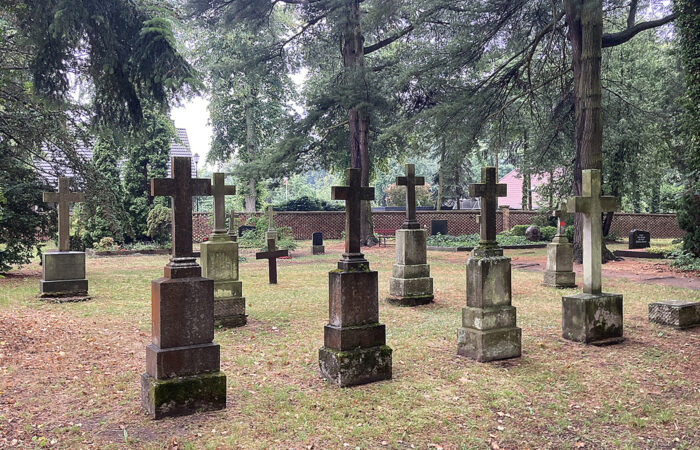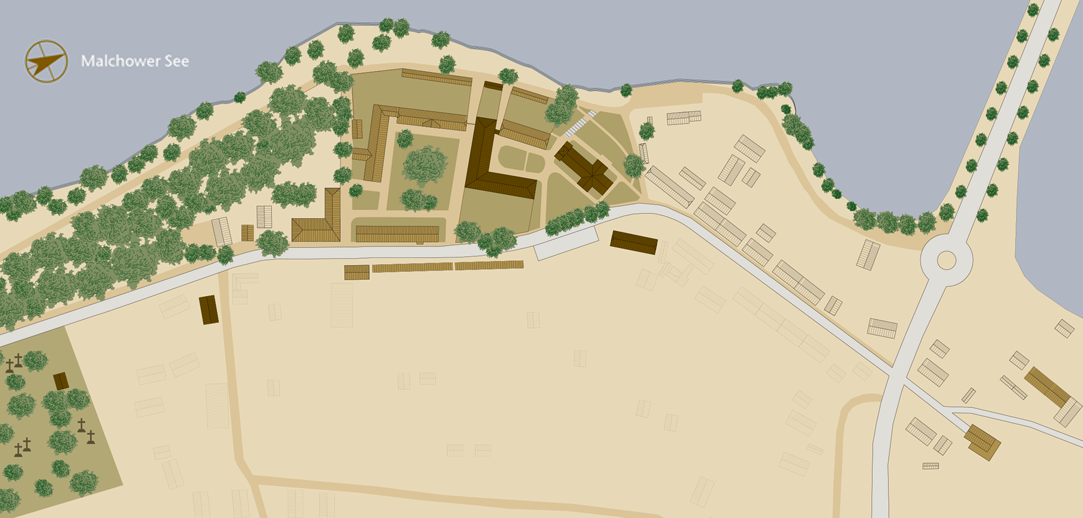
- Home
- 23_Burial Ground of the Conventual
 Burial Ground of the Conventuals | these days
Burial Ground of the Conventuals | these days Burial Ground of the Conventuals | these days
Burial Ground of the Conventuals | these days Burial Ground of the Conventuals | these days
Burial Ground of the Conventuals | these days Burial Ground of the Conventuals | these days
Burial Ground of the Conventuals | these days The last deaconess of the Malchow Monastery Gertrud von Lücken | 1962
The last deaconess of the Malchow Monastery Gertrud von Lücken | 1962
The Burial Ground
Malchow Monastery
Burial Ground of the Conventuals
SHOW THE TEXT
Burial Ground of the Conventuals
In 1572, in the course of the Reformation and instigated by the Knights of Mecklenburg, the Catholic monastery was converted into an aristocratic Protestant convent. Thereafter it was to facilitate the appropriate care for unmarried daughters of the Protestant faith.
SHOW THE WHOLE TEXT
The families of the long-established Mecklenburg aristocracy as well as noble families who were officially admitted into these institutions, were entitled to cloisters. If the daughters did not marry, they were then entitled to a financial allowance from the monastery – the elevations were staggered in increments and were usually paid quarterly to the canonesses living abroad. Only the canonesses, who, after a long period of waiting had moved up to the full payment in cash or kind and were then already of an advanced age, received one of the conventual apartments in the monastery and moved to the Malchow convent. In addition to free housing and monetary support, the full payment was mainly associated with extensive deliveries of natural resources from the monastery farm, such as firewood, game, fish and stabling. Each conventual lived in one of the spacious terraced houses on the convent and managed her own household with the help of a maid.
From the 18th to the 20th century, the Malchow convent permanently consisted of 14 conventuals and the deaconess, as the superior or abbess in the state monasteries of Mecklenburg was commonly known.
After the revolution in November 1918, the state monasteries were dissolved. Monastic property was nationalized and placed under the auspices of the new state government, while the monasteries’ assets and estates were initially administered by the Ministry of Finance.
The monastery lawsuits were brought by the knights of Mecklenburg and a number of canonesses at the beginning of the 1920s. The private claims of the co-plaintiffs and prospective nuns were upheld. The compensation entitlement was regulated at the suggestion of the state parliament’s monastery committee, based on the previous monastery regulations. The expectants registered by 1918 were able to be reintegrated, and advanced in the financial elevations as of 1924. The last conventual moved into the convent in 1947.
Between the end of the 17th century and 1918, a total of 1,205 noble daughters were recorded in the register and had received an acceptance. Of these, an estimated one in seven was assigned a monastery apartment at an advanced age with full elevation, and as of then actually lived in the Malchow convent.
The roomy apartments were reduced in space and rationalised as early as the 1920s. Slowly but surely other residents moved into the monastery, mainly due to the great lack of living space in Malchow. From the 1940s on, war refugees in particular were housed with their families in the monastery for many decades.
With the death of the last conventual and deaconess, Gertrud von Lücken, in 1972, the history of the Malchow State Monastery as an aristocratic convent irrevocably ended after 400 years.


Embankment

Laundry

Hospital

Smithy

Bulwark and Promenade

Church

Parsonage

Cloister Courtyard

Refectory

Dormitory

Deaconess's house

Wall Garden

Ladies' Retreat

Terraced Houses 1

Kitchen Master’s House

Terraced Houses 2

Administration Building

Jail

Barn terraced houses
and farm yard

Engels Garden

Monastery Cemetery

Cemetery Chapel

Burial Ground of the Conventual

Cartwright's Workshop
SHOW ALL OBJECTS
Embankment
Laundry
Hospital
Monastery Smithy
Bulwark and Promenade
Monastery Church
Parsonage
Cloister Courtyard
Refectory
Dormitory
Deaconess's house
Wall Garden
Ladies' Retreat
Terraced Houses | 1
The Kitchen Master’s House
Terraced Houses | 2
Administration Building
Jail
Terraced stable houses and farmyard
Monastery Cemetery
Cemetery Chapel
Burial ground of the conventuals
Cartwright's Workshop
Exact location in Google Maps

Mit dem Laden der Karte akzeptieren Sie die Datenschutzerklärung von Google.
Mehr erfahren
